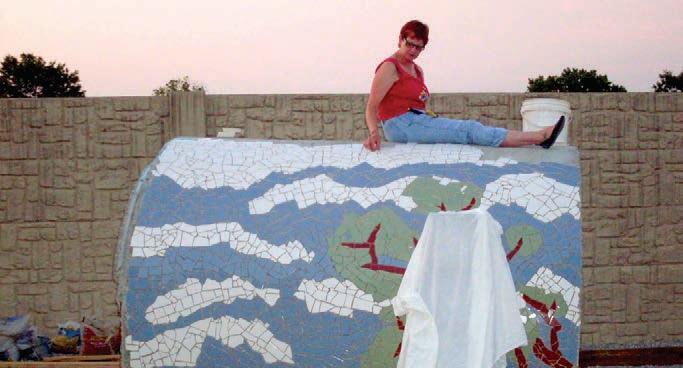
8 minute read
Culture
29
[THEATERS]
Advertisement
Tivoli Theatre Sold to a Church
Written by JAIME LEES
The historic Tivoli Theatre (6350 Delmar Boulevard, 314727-7271) in the Delmar Loop is being sold to a church.
Property developer Joe Edwards has owned the theater since 1994, but he handed over the keys to One Family Church, which has had a home just down the block in a floor of the Riverfront Times’ old office .
In addition to leasing the Tivoli out to Landmark Theatres until COVID-19 hit, Edwards also rented out the space to One Family Church, which has held Sunday services at the theater for the past decade.
Pastor Brent oam of ne amily Church says that the theater will still operate through the week and rent to retail clients. In a news release, Roam said he’s “excited for the opportunity to provide retail space for vibrant and growing businesses on the Delmar Loop, and reasonably priced, exciting, and socially relevant films for students, families and film lovers from all over the St. ouis region, while also providing passionate and life giving church services on Sundays.”
Along with being a pastor, Roam is a former actor with a long resume of B horror flicks.
We’ll have to see how that background influences offerings on the Tivoli schedule, which in the past has included anything from John Waters movies to screenings of vintage D porn films to midnight showings of The Rocky Horror Picture Show.
Pastor Roam is aiming to start showing movies at the Tivoli this fall. n
e Tivoli eater is now under new management. | VIA FLICKR/PAUL SABLEMAN
[ART]
Pipe Dreams
St. Louis artist selling tile-covered “Sewer Pipe House”
Written by DANNY WICENTOWSKI
Artist Jeanne Spezia never intended to actually live inside the massive sewer pipe she keeps on the side of her driveway. Covered in mosaic tiles and representing years of work, the eightfoot-long concrete pipe turned up on Facebook marketplace recently with an asking price of $100.
The listing for a “Sewer Pipe House” has already attracted potential buyers. But in an interview with RFT, its creator explains that it had started as an idea for a kind of art gallery spread across a curved concrete canvas.
“I wanted to make a mosaic sewer pipe that you could walk through,” Spezia says. “They delivered it on a flatbed, and just dropped it. They’re very heavy, about 13,000 pounds.
“I tiled it inside and out,” she adds. “So now it’s probably heavier.”
Spezia says she purchased the pipe around 2013 and spent the next two years transforming it into something far more artful than its intended purpose. But the plan for a walkthrough art installation changed after she read about the Dasparkhotel in Austria, which uses converted city drainage pipes as cozy hotel rooms with “maximum comfort in a minimal amount of space.”
She remembers deciding, “Let’s make ours a pod.”
Spezia got to work, laying more than a thousand pieces of cut tile and turning the dull gray concrete into a work of art while her husband framed the interior, installed a pull-down table and added a window on the other end.
By the end, Spezia had covered every inch in tile. The interior is a nightscape complete with stars.
On the exterior, one side shows a tree spreading its branches against a blue sky. The other features a close-up portrait of the artist herself.
Spezia says she completed the work in 2015. The interior features a chalkboard finish to the new walls, allowing visitors to write or draw with chalk if they wish. Battery-powered lights illuminate the tiled night sky, and her husband added a frame for a bed.
Not long after finishing the project, Spezia says she and her husband planned to spend the night on New Year’s Eve. That same night, her year-old dog escaped from an unlocked gate and, tragically, was struck and killed by a car.
Years later, Spezia says it was that loss that brought the pipe to market.
“I was in a hurry and didn’t close the gate that night, and I just can’t look at this pipe anymore, because it brings back that memory,” she says. “It’s been bugging me, and I just want to get rid of it.”
So far, she says one prospective buyer is waiting for approval to move the pipe to his property. Another has offered to pick it up immediately, though she advises that any buyer will need a flatbed truck and “can’t just roll it out of here.”
Still, she says the attention toward her Facebook listing has been gratifying, though it’s come at a time when she’s ready to give up the product of so much time and effort.
“My husband could just destroy it, but my friend said that I could put it up on Facebook marketplace, and it’s already got some 6,000 views. It’s just funny,” she adds, “Nobody cared about it while I was on there doing it, but now that I’m going to get rid of it, everybody is interested.” n

Jeanne Spezia, shown sitting atop the pipe as she covered its concrete surface with tiles. | JEANNE SPEZIA

Simply the Best
Tina Turner HBO documentary TINA pays tribute to a music legend
Written by JAIME LEES
Recently released on HBO, the documentary TINA aims to chronicle R&B legend Tina Turner’s ambition, her talent, her struggles and her rise to fame that all started right here in St. Louis.
Born Anna Mae Bullock in Brownsville, Tennessee, Turner moved to St. Louis as a youngster. She started building a name for herself in high-energy local venues like the Club Imperial when she was only a teenager, after picking up a hot mic and singing with an established band when she was just seventeen.
Though she was still in high school, Turner started performing every weekend, leading a dual life of both a schoolgirl and a glamorous entertainer clad in fancy dresses beneath fur coats.
“I wasn’t thinking of, ‘I’ll go to St. Louis and I’ll start singing and I’ll be a star,’” Turner says in the documentary. “I was young. Naive. Just a country girl, and everything just opened up to me.”
TINA follows Turner’s rise from St. Louis to superstardom. Beginning with her hit 1960 single “A Fool in Love,” Turner captured international audiences with her energy and authenticity. From that first ey, hey, hey, hey, hey, listeners knew that Turner was something special.
Translated into secular culture, her roots in gospel and Baptist church music had Turner taking on the role of a naturally sexy soul revival preacher, which made her performances far more thrilling than many others’ during that time. While the majority of her peers were doing tightly rehearsed steps while singing, Turner danced powerfully and unpredictably, exploding like a firework on stage.
“I was standing there watching her and saying, ‘Whatever that is, I want some of that,’” Oprah Winfrey says in TINA. “I got the spirit. It was no different than being in a church where you are moved and stirred to the point where you could feel it inside yourself.”
After slaying audiences with performances of songs like “River Deep – Mountain High” and “Proud Mary,” Turner took some time out of the public eye before returning with one of the greatest comebacks of all time.
By the 1980s, Turner’s ambition was still in full force, and she set her sights on a bigger goal: to be the first Black rock singer to sell out football stadiums. She even invented a whole new look to represent her new rock-babe persona, wearing her hair bigger and her skirts shorter.
At age 1, urner scored her first (and only) No.1 on the Billboard Hot 100. “What’s Love Got to Do with It” off of her multi-platinum Private Dancer album also won a Grammy for Record of the Year. Her success didn’t end there, though: Turner went on to release many other hits including “We Don’t Need Another Hero (Thunderdome)” and “I Don’t Wanna Fight.”
Her live concerts were mega productions, drawing in thousands each night and, yes, she did become the first modern Black rock singer to consistently sell out football stadiums. But then she executed a calculated fade from the spotlight.
“Some people say the life that I lived and the performances that I gave, the appreciation is blasting with the people. And, yeah, I should be proud of that — I am — but when do you stop being proud?” Turner continues. “How do you bow out slowly? Just go away?”
The documentary team catches up with Turner in the present day as she reminisces about the past and the decisions she’d made regarding her life and career.
She lives quietly now, in Switzerland, having given up her American citizenship after obtaining Swiss citizenship in 2013. Her home is opulent but homey, a light filled and peaceful place that looks like the perfect spot to spend one’s golden years. n the film, her husband called the documentary “a closure,” a way for Turner to bow out gracefully. She is reportedly facing serious health problems, and audiences get the sense that this documentary is her last attempt at telling her own story.
Tina Turner’s life and career have always been described in terms of her relationship to men. Her misfortunes have always taken the spotlight when her personal strength, groundbreaking raw talent, incandescent performances and weighty contribution to the history of American music should’ve been the focus all along.
Turner was introduced to a whole new generation of fans recently when her song “The Best” was featured multiple times on the Emmy Award-winning comedy Schitt’s Creek. It’s possible that these fans will want to know more about Turner and will search out the TINA documentary.
From there, through videos of her old performances, they’ll learn what we’ve all known in St. Louis for decades: Tina Turner really is simply the best. n

HBO’s new documentary tracks Tina Turner’s rise from a St. Louis teen to an international superstar. | HBO/OFFICIAL RELEASE POSTER








